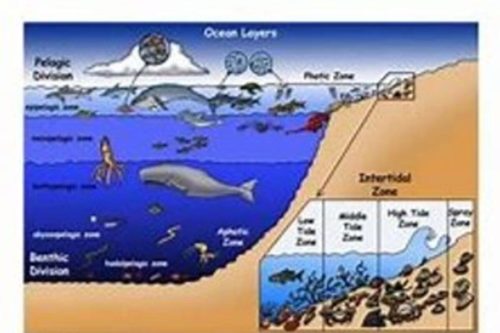You remember from school the process plants use to take energy from the sun and convert Co2 to produce oxygen (photosynthesis). Turns out most of the plant life on our planet is in microscopic form called phytoplankton that lives in the sunlit layer of our oceans, (called the euphotic zone for science-type folks). Phytoplankton absorbs energy from the Sun and Co2 and nutrients from deep water. Through the process of photosynthesis, phytoplankton releases molecular oxygen (O2) into the water. It is estimated that between 50% and 85% of the world’s oxygen is produced via phytoplankton photosynthesis. Most of these tiny plants are too small to be individually seen with the unaided eye. Sometimes we can see them when there are high concentrations, as the colored patches on the water surface due to the presence of chlorophyll within their cells during algae blooms. The food that phytoplankton needs is primarily macronutrients such as nitrate, phosphate, or silicic acid, whose availability is governed by the balance between the so-called biological pump and upwelling of deep, nutrient-rich water. Oceans are CO2 sinks, and represent the largest active carbon sink on Earth, absorbing more than a quarter of the carbon dioxide. So, these two phytoplankton-sustaining ingredients are found deep in the ocean and well below the sun-lit zone.

How do whales have anything to do with this?
Today, we know whales dive as deep as 6,000 feet (more than a mile below the surface of the ocean) and routinely dive 1,500 to 3,000 feet, certainly well out of the euphotic zone. Consider this, the whales we often see here around Sitka weigh generally in the 40-ton range, (comparable to 5-6 elephants) and are the size of a school bus, (40-50 feet long) so, when they propel themselves up from the depths the resulting upwelling of water brings nutrient-rich and Co2 laden water into the sunlit zone, nourishing the phytoplankton that sustains life. Also, consider the frequency of diving and surfacing over course of a day for all whales to understand the breadth, (pun intended) and effect whales have on Oxygen production. The attached video clip only shows a small segment of time, but we witness the upwell from humpbacks extending well beyond 5 minutes and in a diameter exceeding 30 feet from just a single whale.
Remember the 50% to 85% figure relating to the amount of O2 produced by phytoplankton? Well, let’s average this, (because science isn’t always spot-on) and say for argument’s sake say, it’s exactly 70%. Now, take only 3 out of your next 10 breaths and see how that works out. That’s how much Oxygen these little plants do to sustain our life on our planet. I cannot find any research that measures or even attempts to quantify the effect Whales have on oxygen production. This is a subject I believe merits a deeper dive into understanding. The more we know about how the marine ecosystem and our planet works (even if not spot-on) as a system the better we can interact, intervene and educate our species (humanoids) to sustain life as we know it.
Oh yeah, the farming part:
Phytoplankton are also the foundation and the base of the aquatic food chain. Zooplankton, (most are microscopic organisms except the beautiful jellyfish) feed on the phytoplankton. Krill and other small organisms then feed on the zooplankton and so on up the chain. So, when whales come up from the deep, they bring the vital nutrients and Co2 that helps grow their own food thus my reason for calling them the farmers of the sea.
#whales #whalewatching #whalephotography #hydrophone #sitkaalaska #bubblenetfeeding #wildlifetour